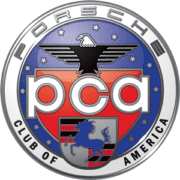On Track November 2011
Like many, the Glen is my favorite track, but improvements have come slowly for me the last few years. My car is pretty well set up, but a few corners had become frustrating as the car just did not want to turn in. First, David drove the car for few laps, something he did not have the opportunity to do last year. The ride was eye-opening and humbling at the same time. I drove the same line as David, but the big difference was corner entry speed and how much he was working the front tires. The other aspect was how smooth he drove; like a pro at any sport, he made driving fast look easy. David explained the three components of getting the car to turn: speed, steering input, and how quickly the driver comes off of the brakes. As David preaches the last 5% of braking is the most important for keeping the car balanced upon turn entry, coming off of the brakes quickly is his least favorite technique for influencing turn-in. Assuming the line and steering input is correct, then entry speed is what I needed to focus on. For some corners, just an additional one mph was necessary to get the front tires to bite, and resulting in the car turning. I should note that for especially novice and intermediate drivers that increasing corner entry speed is one of the last things to focus on, as faster entry speeds require a very high level of precision, smoothness and driving control. This is not contrary to the mantra “slow in, fast out” which should be the focus of most drivers. At a higher level of driving this becomes “fast in, faster out”. Over-driving and trying to ‘force’ a car into a corner is a common mistake and actually compromises corner exit speed.
At the conclusion of track activities on Day 1, David conducted a “virtual” track walk of Watkins Glen for a big crowd of drivers. As we enjoyed some adult beverages, David took us around the track using pictures to analyze each turn, capped off by an in-car video of him driving a 997 Cup car at speed. The presentation generated some good discussions, and everyone came away with a few things to think about during the next day of driving.
The penultimate event of the season was Lightning, the week before Watkins Glen. Most of us were just recovering from the effects of Hurricane Irene when a tropical storm delivered additional unwanted rain less than two days prior to the event. On Wednesday evening I had picked up the club van from Rockaway and had left my truck in its place. I awoke Thursday morning, day of departure for Lightning, to water dripping from the bathroom ceiling. At 5:00 am, I crawled into the attic and determined that the leak would be easy to fix, and conveniently the water was coming in over the shower area where a drain could take care of it. I convinced myself this was a minor inconvenience and headed out to work. To save some time later in the day, I had planned to leave for Lightning directly from work, so I had my trailer in tow. As with many parts of the state, the road flooding in Sussex County was worse following the tropical storm than it had been during the hurricane. Within two miles of my house I encountered a flooded road and had to accomplish an awkward turnaround and find an alternate route. A few more miles and I encounter another closed road due to downed trees. A tight about face with the van and trailer and another road is found. I finally get to the office with only a half-hour delay.
I had no sooner finished my first cup of coffee when Jake from Powertech gives me a call. The Rockaway River was on the rise again, and threatening to flood the parking lot where my truck was parked. The hurricane had caused the river to flood the previous week, and I had visions of my truck floating in four feet of water. Unfortunately, I couldn’t do anything until I retrieved my truck keys, left at home an hour away. I unhooked my trailer and trudged from Summit back to Lafayette and then to Rockaway. The road leading to the parking lot was flooded with a foot or so of water, but the truck was still high and dry and the river was already receding. Breathing a sigh of relief, I left my keys with Jake ‘just in case’ and returned to Summit. My plan to save a few hours of driving back-fired, but at least I wouldn’t have any worries over the weekend.
With all previous rain and a dodgy forecast for the event, there were several drivers who did not make the trip to Lightning. Unfortunate, as track was bone dry for all the driving sessions. We had a good group of students who were interested in some classroom teaching to supplement what they were learning on the track. With the help of Heidi Posner who took some in-car video, Scott Studer and I conducted a video classroom session Friday afternoon after the track went cold. The students seemed to take away much from the session, so for future events we will try to incorporate more video into our “chalk-talks”.
The tri-state area had record flooding following the hurricane and tropical storm. The devastation was not limited to our local area: after the hurricane Greene County, NY (includes towns of Windham, Prattsville, Catskill and Hunter Mountain) experienced massive flooding. On the way to Watkins Glen I passed Binghamton, NY, I was shocked to see a mud-line many feet above ground level for what had to be more than 50 miles. I hope that you and your family were safe and were able to return to your home without significant damage.


